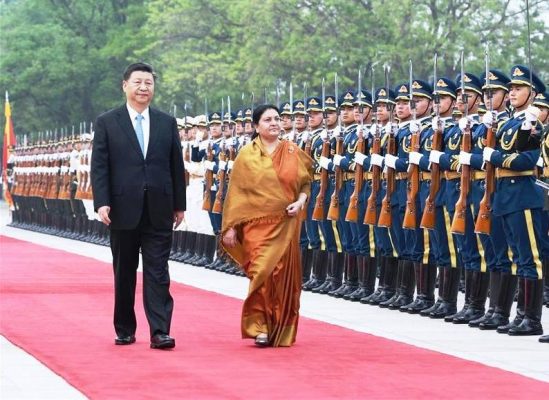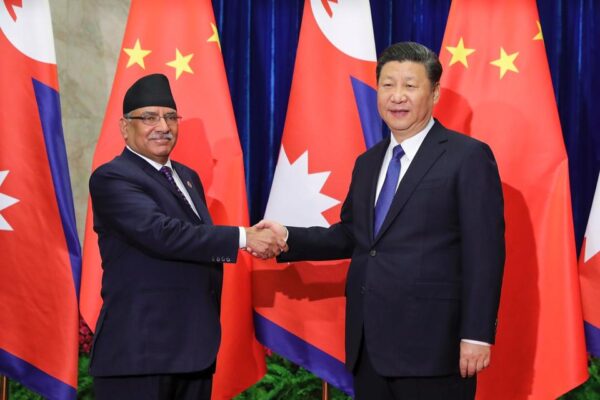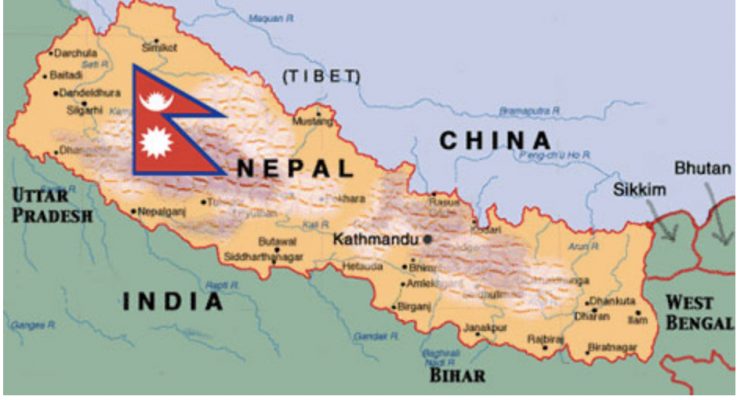
New Delhi. After Chinese President Xi Jinping’s recent Nepal visit to enhance strategic ties between China and Nepal, talks are on in India about both on strategic implications of China-Nepal ties and the future of India’s relationships with Nepal. There is logic behind such apprehension in case of India. In fact, the pacts signed between China and Nepal during the two-day historic visit of a Chinese President to Nepal after 23 years may have larger ramifications for India.
But there are two usual phenomena. One is, Beijing’s daring approach to make strong strategic partnership with all the nations around India. Other is landlocked Nepal’s desperate efforts to have connectivity with the overseas. But both of these are age-worn, at least decades-old issues. This time China-Nepal bilateral partnership has attained new heights. Beijing has stated providing Rs 56 billion assistance to Kathmandu. The two countries signed 18 MoUs comprising different sectors such as transport, agriculture, industry, commerce and supply. However, these are certainly not issues of much concern for New Delhi.
There are some concerning aspects for India which got unveiled during Chinese President’s Nepal visit this time. China and Nepal have agreed to intensify the implementation of projects under Belt and Road Initiative (BRI) under Trans-Himalayan Multidimensional Connectivity Network umbrella announced in 2018 regarding which India has certain objections. The proposed rail network will extend to Pokhara and Lumbini. China has expressed willingness to initiate the project making road-accessibility between Kathmandu and Rasuwagadhi that will reduce the distance of the northern border. The Rasuwagadhi border has emerged as a key alternative to the Tatopani border, which recently opened after the 2015 earthquake damaged it.

Nepal’s quest for connectivity received a further boost with China agreeing to develop the key border points of Mustang, north of Pokhara, Kimathanka in the east and Hilsa in the west. Similarly important is extending the agreement of enhancing security co-operations. Media reports stated that it was agreed that 100 Nepali security personnel would travel to China every year till 2022. Reality is China’s policy framework is targeted to utilise Nepal for harnessing Beijing’s strategic interests in Tibet. China has also offered Nepal to use Chinese ports and others to ensure its connectivity in the region and beyond. Looking all these from any perspective only show larger strategic challenges for India evolving from a nation that virtually heaved on Indian oxygen so far.
More so, timing of the visit of Chinese President to Nepal is also important considering the existing political situation in Kathmandu. Chinese President Xi Jinping met co-chairman of the Nepal Communist Party Pushpa Kamal Dahal; ‘Prachanda’, and to reinforce inter-party exchanges. The Chinese President is reportedly briefing Prachanda on the basic experience of the Communist Party of China (CPC) in exercising full and strict governance over the party, strengthening the building of the ruling party, and consolidating the party’s ruling position.
Too many intricate questions come to the fore on the backdrop of Chinese President’s Nepal visit. Is Nepal emerging as a zone of Chinese strategic interest? If yes, what is the gravity level of this and how much is this challenging for India? Will Nepal give a walkover to China in Tibet against the strategic interests of India? What is the implication of enhanced military co-operation between China and Nepal for India and her security concerns? Is Nepal emerging as laboratory of experimenting Chinese political culture? Above all, do all these mean Nepal overcoming dependence on India completely?

India needs to find out the answers of these questions to shape her future strategic roadmap. However, there is no reason to believe that things will happen as China is planning or Nepal is predicting. In fact, geo-strategic location of Nepal will keep it dependent on India. However, India needs to make Nepal heed the points that are against New Delhi’s strategic interests. A strong message should be sent from New Delhi to Kathmandu. If Nepal continues preferring to remain in the lap of China, India must not hesitate to toughen her stand.
India-Tibet strategic partnership should emerge. India’s interest in Tibet is hampered by China-Nepal strategic axis. Therefore, India needs to react. Better vigilance across India-Nepal border may be helpful for India to make Nepal subdue. Things should be judged not from the perspective of shared values and tradition but considering the given reality. If Nepal does not respect its traditional relations with India, there is no reason for New Delhi exaggerating on this.
Meanwhile, there is another issue related to Nepal. This is potentiality of Nepal gradually evolving in the strategic calculus of the United States. In fact, President Trump has been very much emphatic on the point that America should have a strategic partnership with Nepal bordering China. Washington in its annual home-ministerial reports has been mentioning this with prominence. On the backdrop of repeated setbacks of US strategy in South East Asia, President Trump feels that America should find out new places in this region to feed its strategic agenda. Nepal figures prominently in this new strategic mission of America. Earlier, Washington offered for investment in Nepal. But Nepal dismissed this.

This is becoming quite evident today that American intension cannot be fulfilled in Nepal without India’s support. If needed India may think of such a venture with not only United States but Japan as well to restrict China’s increasing footprint in Nepal. Addition of Japan here will strengthen the venture and provide greater capability to compete China in terms of providing economic aids and investments in Nepal. After all, such a venture led by India can fulfill the economic needs of Nepal in a larger context.
However, for all these, India needs to change the stereotypical approach and emerge strongly. If the periphery across India is transforming into China’s strategic base, this demands something out of box which should be experimented by India. The best option is to play the pressure-game. Aggressive Indian stand is the need of the hour to maintain and extend New Delhi’s strategic hold in this region. This is what will prove to be fruitful in optimising India’s strategic interests in Nepal and give it better nourishment.
The writer is a Guwahati-based strategic affairs expert








